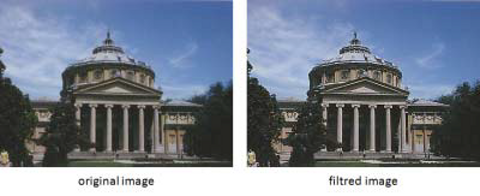UnsharpMasking2d
Sharpens edges on the elements of a two-dimensional image without increasing noise.
Access to parameter description
For an introduction to image filters: see section Images Filtering.
This algorithm is a very common filter that sharpens edges on the elements of an image without increasing noise. It first applies a Gaussian filter to a copy of the original image and blends it with the original. Undesired effects are finally reduced by using a mask to apply the sharpening only on the desired regions (that is, regions for which the gradient is above a certain threshold).

Figure 1. The unsharp masking filter effect
Note: Since the original data range is not preserved by this filter, the output image type is upgraded according to the Image type basic rule.
See also
Access to parameter description
For an introduction to image filters: see section Images Filtering.
This algorithm is a very common filter that sharpens edges on the elements of an image without increasing noise. It first applies a Gaussian filter to a copy of the original image and blends it with the original. Undesired effects are finally reduced by using a mask to apply the sharpening only on the desired regions (that is, regions for which the gradient is above a certain threshold).

Figure 1. The unsharp masking filter effect
Note: Since the original data range is not preserved by this filter, the output image type is upgraded according to the Image type basic rule.
See also
Function Syntax
This function returns outputImage.
// Function prototype
std::shared_ptr< iolink::ImageView > unsharpMasking2d( std::shared_ptr< iolink::ImageView > inputImage, double edgeSize, double edgeContrast, double brightnessThreshold, std::shared_ptr< iolink::ImageView > outputImage = NULL );
This function returns outputImage.
// Function prototype.
unsharp_masking_2d( input_image,
edge_size = 5,
edge_contrast = 0.5,
brightness_threshold = 0,
output_image = None )
This function returns outputImage.
// Function prototype.
public static IOLink.ImageView
UnsharpMasking2d( IOLink.ImageView inputImage,
double edgeSize = 5,
double edgeContrast = 0.5,
double brightnessThreshold = 0,
IOLink.ImageView outputImage = null );
Class Syntax
Parameters
| Class Name | UnsharpMasking2d |
|---|
| Parameter Name | Description | Type | Supported Values | Default Value | |
|---|---|---|---|---|---|
 |
inputImage |
The input image. | Image | Binary, Label, Grayscale or Multispectral | nullptr |
 |
edgeSize |
The radius of the desired edges. | Float64 | >0 | 5 |
 |
edgeContrast |
The contrast amount added at the edges. | Float64 | >0 | 0.5 |
 |
brightnessThreshold |
The minimum brightness threshold. | Float64 | >=0 | 0 |
 |
outputImage |
The output image. Its dimensions are forced to the same values as the input. Its data type is promoted. | Image | nullptr | |
Object Examples
std::shared_ptr< iolink::ImageView > polystyrene = ioformat::readImage( std::string( IMAGEDEVDATA_IMAGES_FOLDER ) + "polystyrene.tif" ); UnsharpMasking2d unsharpMasking2dAlgo; unsharpMasking2dAlgo.setInputImage( polystyrene ); unsharpMasking2dAlgo.setEdgeSize( 5.0 ); unsharpMasking2dAlgo.setEdgeContrast( 0.5 ); unsharpMasking2dAlgo.setBrightnessThreshold( 0.0 ); unsharpMasking2dAlgo.execute(); std::cout << "outputImage:" << unsharpMasking2dAlgo.outputImage()->toString();
polystyrene = ioformat.read_image(imagedev_data.get_image_path("polystyrene.tif"))
unsharp_masking_2d_algo = imagedev.UnsharpMasking2d()
unsharp_masking_2d_algo.input_image = polystyrene
unsharp_masking_2d_algo.edge_size = 5.0
unsharp_masking_2d_algo.edge_contrast = 0.5
unsharp_masking_2d_algo.brightness_threshold = 0.0
unsharp_masking_2d_algo.execute()
print( "output_image:", str( unsharp_masking_2d_algo.output_image ) )
ImageView polystyrene = ViewIO.ReadImage( @"Data/images/polystyrene.tif" );
UnsharpMasking2d unsharpMasking2dAlgo = new UnsharpMasking2d
{
inputImage = polystyrene,
edgeSize = 5.0,
edgeContrast = 0.5,
brightnessThreshold = 0.0
};
unsharpMasking2dAlgo.Execute();
Console.WriteLine( "outputImage:" + unsharpMasking2dAlgo.outputImage.ToString() );
Function Examples
std::shared_ptr< iolink::ImageView > polystyrene = ioformat::readImage( std::string( IMAGEDEVDATA_IMAGES_FOLDER ) + "polystyrene.tif" ); auto result = unsharpMasking2d( polystyrene, 5.0, 0.5, 0.0 ); std::cout << "outputImage:" << result->toString();
polystyrene = ioformat.read_image(imagedev_data.get_image_path("polystyrene.tif"))
result = imagedev.unsharp_masking_2d( polystyrene, 5.0, 0.5, 0.0 )
print( "output_image:", str( result ) )
ImageView polystyrene = ViewIO.ReadImage( @"Data/images/polystyrene.tif" ); IOLink.ImageView result = Processing.UnsharpMasking2d( polystyrene, 5.0, 0.5, 0.0 ); Console.WriteLine( "outputImage:" + result.ToString() );